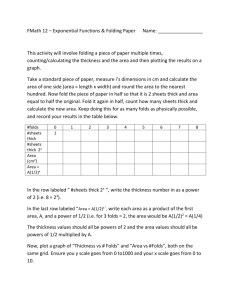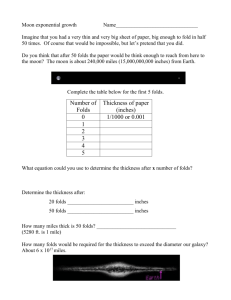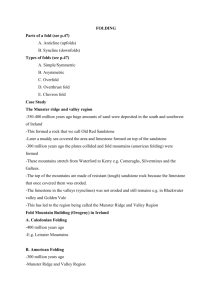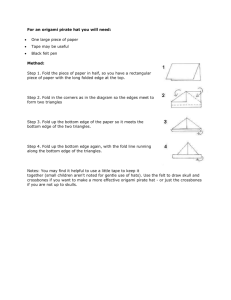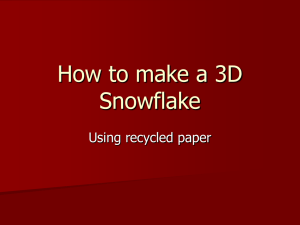Prefix
advertisement
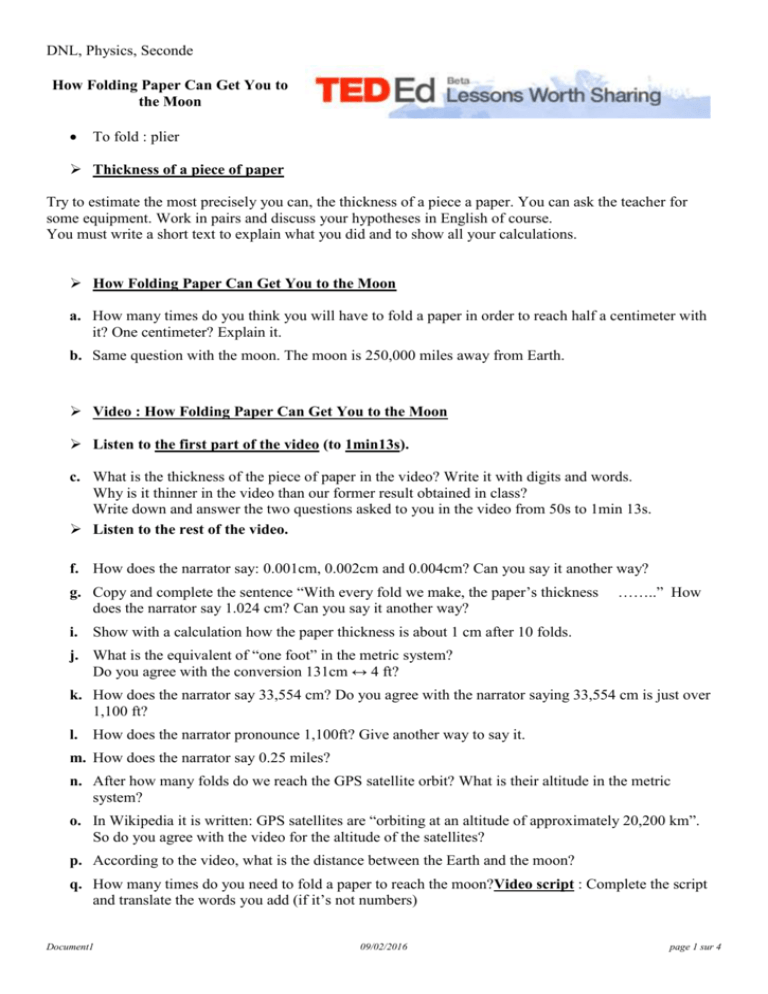
DNL, Physics, Seconde How Folding Paper Can Get You to the Moon To fold : plier Thickness of a piece of paper Try to estimate the most precisely you can, the thickness of a piece a paper. You can ask the teacher for some equipment. Work in pairs and discuss your hypotheses in English of course. You must write a short text to explain what you did and to show all your calculations. How Folding Paper Can Get You to the Moon a. How many times do you think you will have to fold a paper in order to reach half a centimeter with it? One centimeter? Explain it. b. Same question with the moon. The moon is 250,000 miles away from Earth. Video : How Folding Paper Can Get You to the Moon Listen to the first part of the video (to 1min13s). c. What is the thickness of the piece of paper in the video? Write it with digits and words. Why is it thinner in the video than our former result obtained in class? Write down and answer the two questions asked to you in the video from 50s to 1min 13s. Listen to the rest of the video. f. How does the narrator say: 0.001cm, 0.002cm and 0.004cm? Can you say it another way? g. Copy and complete the sentence “With every fold we make, the paper’s thickness does the narrator say 1.024 cm? Can you say it another way? ……..” How i. Show with a calculation how the paper thickness is about 1 cm after 10 folds. j. What is the equivalent of “one foot” in the metric system? Do you agree with the conversion 131cm ↔ 4 ft? k. How does the narrator say 33,554 cm? Do you agree with the narrator saying 33,554 cm is just over 1,100 ft? l. How does the narrator pronounce 1,100ft? Give another way to say it. m. How does the narrator say 0.25 miles? n. After how many folds do we reach the GPS satellite orbit? What is their altitude in the metric system? o. In Wikipedia it is written: GPS satellites are “orbiting at an altitude of approximately 20,200 km”. So do you agree with the video for the altitude of the satellites? p. According to the video, what is the distance between the Earth and the moon? q. How many times do you need to fold a paper to reach the moon?Video script : Complete the script and translate the words you add (if it’s not numbers) Document1 09/02/2016 page 1 sur 4 How many times can you …………………….. a piece of paper? …………………. that one had a piece of paper that was very fine, like the kind they …………….. use to print the Bible. In reality, it seems like a piece of ……………….. To clarify these ideas, let's say you have a paper that's …………………………….………… of a centimeter in ……………. That is 10 to the power of ………………………. three centimeters, which equals .001 centimeters. Let's also assume that you have a big piece of paper, like a page out of the …………………... Now we begin to fold it in half. How many times do you think it could be folded like that? And another question: If you could fold a paper over and over, as many times as you …………..…., say ………………………. times, what would you imagine the thickness of the paper would be then? Before you move on, I encourage you to actually think about a possible answer to this question. OK. After we have folded the paper once, It is now …………………………. of a centimeter in thickness. If we fold it in half once again, the paper will become ………………………….. of a centimeter. With every fold we make, the paper …………….. in thickness. And if we continue to fold it again and again, always in half, we would ……………………….. the following situation after 10 folds. Two to the power of 10, meaning that you ………………….. two by itself 10 times, is one thousand and 24 thousandths of a centimeter, which is a little bit over one centimeter. Assume we continue folding the paper in half. What will happen then? If we fold it ……………………… times, we'll get a thickness of two to the power of 17, which is ………………… centimeters, and that equals just over four feet. If we were able to fold it ……………………….. times, then we would get two to the power of 25, which is 33, 554 centimeters, just over 1,100 feet. That would make it almost as tall as the Empire State Building. It's ……………………. to stop here and reflect for a moment. Folding a paper in half, even a paper as fine as that of the Bible, 25 times would give us a paper almost a quarter of a mile. What do we learn? This type of growth is called ………………. growth, and as you see, just by folding a paper we can go very …………., but very …………….. too. Summarizing, if we fold a paper ……………………… times, the thickness is almost a quarter of a mile. ……………………. times, the thickness reaches ………………………….. miles, which is about the average height that planes fly. Forty times, the thickness is nearly 7,000 miles, or the average GPS satellite's orbit. …………………………… times, the thickness is way over one million miles. Now, if you think that the distance between the Earth and the Moon is less than ……………………………………. miles, then starting with a piece of Bible paper and folding it 45 times, we get to the Moon. And if we double it one more time, we get back to Earth. Document1 09/02/2016 page 2 sur 4 Notes professeur : Source : http://ed.ted.com/lessons/how-folding-paper-can-get-you-to-the-moon Or : http://www.youtube.com/watch?v=AmFMJC45f1Q Matériel : feuilles de papier + 4-5 ramettes de papier. 500 pieces of paper are 53 milliters so one piece of paper is about 0.1 millimeters On peut aussi prendre des encyclopédies ou des dictionnaires. Video : How Folding Paper Can Get You to the Moon Listen to the first part of the video (to 1min13s). a. What is the thickness of the piece of paper in the video? Write it with digits and words. 10-3cm=0.001cm ten to the power of minus three one thousandth of a centimeter b. Why is it thinner in the video than our former result obtained in class? They use Bible paper. c. Write and answer the two questions asked to you in the video from 50s to 1min 13s. How many times do you think you could fold it ? What would be the thickness of the paper folded 30 times? Listen to the continuation of the video. d. How does the narrator pronounce: 0.001cm , 0.002cm and 0.004cm ? Can you give another way to say it ? (one thousandth of a centimeter .. two thousandths, four) e. Rewrite and complete the sentence “With every fold we make, the paper …….. “ f. How does the narrator say 1.024 cm ? one thousand and 24 thousandths of a centimeter Can you say it another way ? One point zero two four g. Show by a calculation how the paper thickness is about 1 cm after 10 folds. h. What is “one foot” in the SI? Do you agree with the 131cm for 4 ft.? 30.48cm i. How does the narrator pronounce 33,554cm? thirty three thousand five hundred and fifty four cm Do you agree with the 1,100ft? j. How does the narrator pronounce 1,100ft? Give another way to say it. Eleven hundred feet / One thousand one hundred feet k. How does the narrator say 0.25mile? A quarter of a mile l. After how many folds do we reach the GPS satellite orbit? What is their altitude in the SI? 1 mile = 1.61km m. On Wikipedia it’s written: GPS “orbiting at an altitude of approximately 20,200 km” so do you agree with the video for the altitude of the satellites? n. According to the video, what is the distance between the Earth and the moon? 250,000miles o. How many times do you need to fold a paper to reach the moon? 45 times Script : How many times can you fold a piece of paper? Assume that one had a piece of paper that was very fine, like the kind they typically use to print the Bible. In reality, it seems like a piece of silk. To clarify these ideas, let's say you have a paper that's one-thousandth of a centimeter in thickness. That is 10 to the power of minus three centimeters, which equals .001 centimeters. Let's also assume that you have a big piece of paper, like a page out of the newspaper. Now we begin to fold it in half. How many times do you think it could be folded like that? And another question: If you could fold a paper over and over, as many times as you wish, say 30 times, what would you imagine the thickness of the paper would be then? Before you move on, I encourage you to actually think about a possible answer to this question. Document1 09/02/2016 page 3 sur 4 OK. After we have folded the paper once, it is now two-thousandths of a centimeter in thickness. If we fold it in half once again, the paper will become four-thousandths of a centimeter. With every fold we make, the paper doubles in thickness. And if we continue to fold it again and again, always in half, we would confront the following situation after 10 folds. Two to the power of 10, meaning that you multiply two by itself 10 times, is one thousand and 24 thousandths of a centimeter, which is a little bit over one centimeter. Assume we continue folding the paper in half. What will happen then? If we fold it 17 times, we'll get a thickness of two to the power of 17, which is 131 centimeters, and that equals just over four feet. If we were able to fold it 25 times, then we would get two to the power of 25, which is 33, 554 centimeters, just over 1,100 feet. That would make it almost as tall as the Empire State Building. It's worthwhile to stop here and reflect for a moment. Folding a paper in half, even a paper as fine as that of the Bible, 25 times would give us a paper almost a quarter of a mile. What do we learn? This type of growth is called exponential growth, and as you see, just by folding a paper we can go very far, but very fast too. Summarizing, if we fold a paper 25 times, the thickness is almost a quarter of a mile. Thirty times, the thickness reaches 6.5 miles, which is about the average height that planes fly. Forty times, the thickness is nearly 7,000 miles, or the average GPS satellite's orbit. Forty-eight times, the thickness is way over one million miles. Now, if you think that the distance between the Earth and the Moon is less than 250,000 miles, then starting with a piece of Bible paper and folding it 45 times, we get to the Moon. And if we double it one more time, we get back to Earth. Document1 09/02/2016 page 4 sur 4


